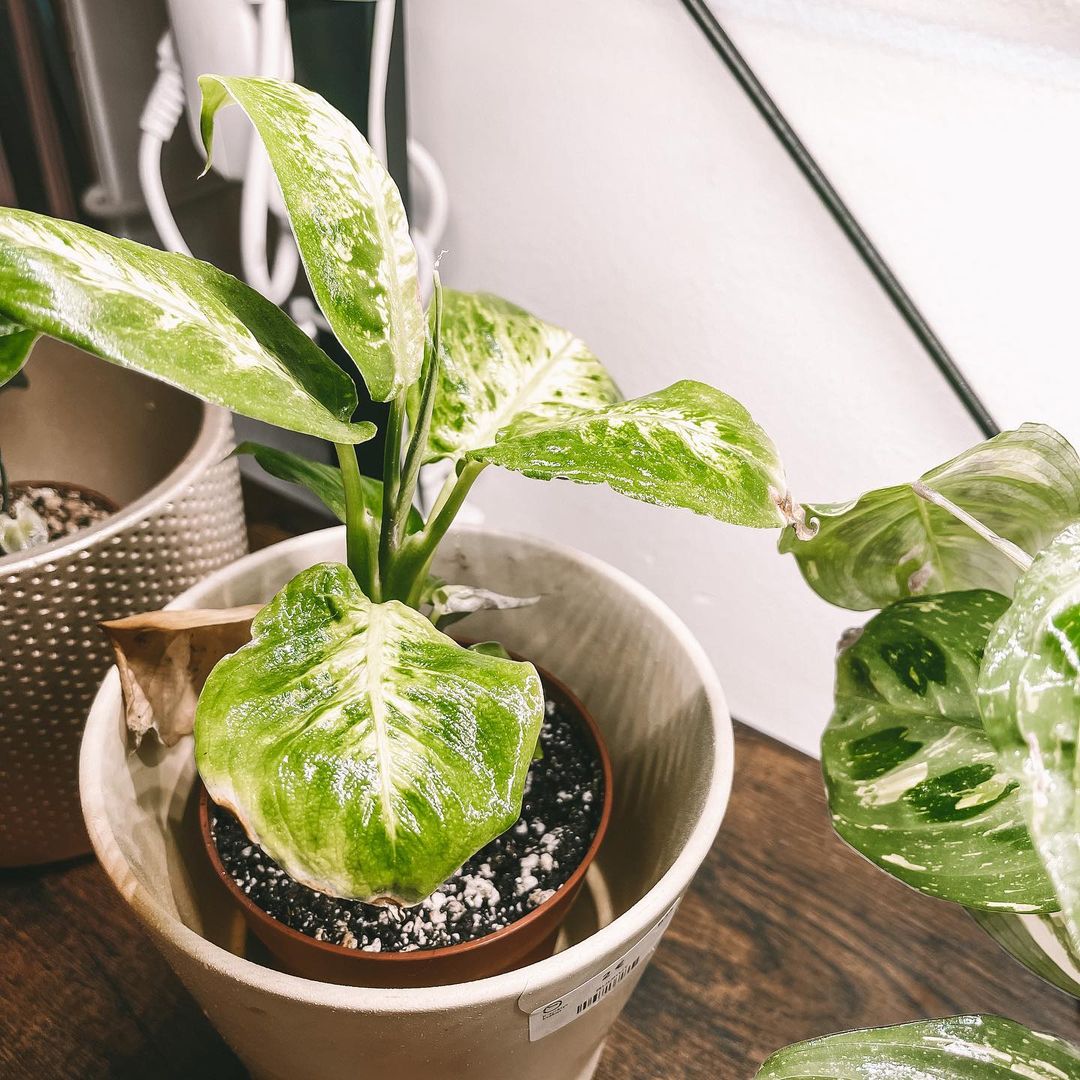Dieffenbachia boasts variegated, speckled, blotched, or roughly striped leaves in white, cream, and green hues, but it can be equally harmful to your pets!
Any carelessness can put your dog’s life in danger, so prevention and immediate action is the best thing to opt for at such bitter times.
Table of Contents Show
What Makes Dieffenbachia Toxic to Dogs?
Dieffenbachia, like most aroids, contains harmful calcium oxalate crystals in the roots, stem, and leaves, rendering it toxic to humans and dogs!

Plant parts contain Oxalic Acid in the form of long, microscopic, and sharp needle-like insoluble raphide and Asparagine.
About 1 gram of oxalic acid is fatal enough to kill your canid companion!
Among Dieffenbachia varieties, keep your dog away from Dieffenbachia Camille, Dieffenbachia Maculata, Dieffenbachia Seguine, and Dieffenbachia Picta.
Symptoms of Dieffenbachia Poisoning in Dogs
Dogs may suffer from eye infections, skin rashes, vomiting, respiratory issues, blistering and swelling of the tongue, mouth, and throat by contact or after consumption.
Many symptoms after contact or consumption vary depending on the exposed body parts, like the mouth, eyes, and skin.

DIY Diagnosis of Dieffenbachia Poisoning
Sometimes the symptoms may take around 2 hours to appear, but signs may pop earlier depending on the part or amount of the plant ingested.
Nevertheless, confirm the following signs before seeking veterinary help.
- Look inside or around the dog’s muzzle for plant debris.
- On finding the chewed parts, save them for later when you take your pet to the hospital.
- To know your pet’s presence around the plant, look for any paw scratches or disturbances in the potting soil.
- Examine if your dog’s rubbing its head, itching, drooling, pawing at the eyes and face, or showing any respiratory troubles.
- Take photos of the body parts to know if the symptoms are receding or snowballing for later.
First Aid for Dieffenbachia Poisoning in Dogs
The immediate thought of any pet lover in case of plant poisoning is to rush and seek expert help.
But if the situation is slowly escalating, prepare for some instant homemade treatment to relieve your dog from the stress.
Following are the first aid therapies depending on the exposed area.
1. Oral Exposure
- First, bring your dog to an open area with light so it can breathe freely.
- Rinse your dog’s mouth with milk, saline, or ice-cold water to ease the burning and wash the plant bits away.
- Don’t encourage your dog to vomit, as it may worsen the situation.
Milk contains calcium that nutralize the oxalate crystals present in the plant parts.
2. Ocular Exposure
- Clean the eyes with saline water to stop the itchiness and rashes.
- While you do it, avoid touching other body parts of the dog with your hands.
- Cover the eyes with a moist towel to allay the dreadful sensation.
3. Topical Exposure
- Prevent your dog from pawing around the mouth or eyes with its infected legs.
- Wash the skin with warm and soapy water to wipe the toxins.
Some effective kits like ARCA PET First Aid and ZeekPet Medical Bag are helpful in these grave situations.
Avoid giving any over-the-counter medicines to your dogs.
But, you can offer activated carbon as per the vet’s instructions to adsorb the toxins from the body.
If the symptoms last even after the efforts, contact these hotline emergency numbers.
Recovery of Dieffenbachia Poisoning in Dogs
The recovery time from the poisoning depends on the number of parts and amount ingested.
Common symptoms will likely recover in 12 to 24 hours, but it takes about a week to recover in severe cases.
Oral exposure and ingestion are hard to treat because the toxins affect vital organs like the kidneys and the liver.
So, avoid food containing fats and proteins, and offer bland and easily digestible food for 24 to 48 hours.
Keep up with the prescribed medicines from the vet and give plenty of liquid until recovery.
How to Prevent your Dog from Eating Dieffenbachia?
Dogs, especially in their growing years, are playful with a habit of chewing everything in sight.
As such, having a toxic plant around is pretty risky!
You can consider the following measures to stop your dog from eating Dieffenbachia.
- Place your Dieffenbachia in high table racks or hang them away from puppies.
- Toss the trimmed parts or leaves away and avoid laying them on the floor.
- Cage or cone your dog when it’s home alone.
- Place your plants under glass arrangements or inside terrariums.
- Spray strong coffee around potted Dieffenbachia plants to deter the dogs.

Locating Dieffenbachia away from dogs is one thing, but you also need to keep the plant away from your feline buddies!
Final Thought!
Your Dieffenbachia plant and dog can coexist peacefully with proper care and attention.
Even if your pup manages to chew the parts of the plant, there’s nothing to worry about if you offer recovery measures on time.
But prevention is always better than cure, so keep your dog and plant away from each other if possible.


